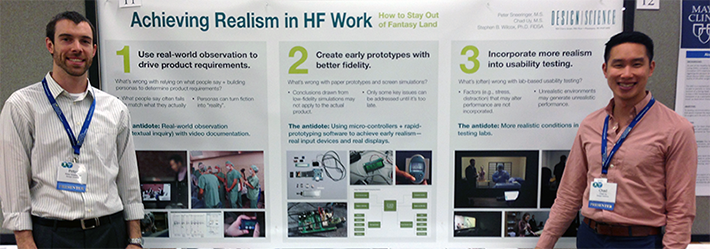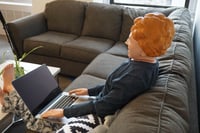Achieving Realism in HF Work—How to Stay out of Fantasy Land
/ in usability testing , human factors , news , presentations , prototyping / by Design ScienceWe attended the HFES Healthcare Symposium in Chicago last month. Among the highlights were hearing keynote speaker Lisa Sanders talk about how the TV show House relates to Human Factors, taking a tour of the GfK facilities, seeing our own Steve Wilcox present on the future of Medical Devices, and presenting our poster on Realism in Product Design.
Simulation, broadly defined, is at the core of medical-device development. We simulate device users and what they do by creating personas and use cases. We simulate the devices themselves via breadboards and prototypes. We simulate environments of use to conduct usability testing with our prototypes.
It’s obvious to say that the whole process only works well when the simulations are adequately accurate. If our personas don’t accurately reflect actual users, we’re at risk of doing a great job of solving the wrong problems. If our prototypes don’t have enough fidelity, we may obtain data about errors and preferences that are artifacts of the prototypes rather than reflective of responses to the actual product. If we don’t adequately simulate use environments for our usability testing, we may develop products that work well in our testing environments but not in the actual environment of use.
[av_heading heading='1. Use real-world observation to drive product requirements.' tag='h6' color='' custom_font='' style='' size='' subheading_active='' subheading_size='15' padding='0' av_uid='av-27lcc'][/av_heading]
What’s wrong with relying on what people say + building personas to determine product requirements?
- What people say often fails to match what they actually do.
- Personas can turn fiction into “reality”.
The antidote: Real-world observation (contextual inquiry) with video documentation.
[av_heading heading='2. Create early prototypes with better fidelity.' tag='h6' color='' custom_font='' style='' size='' subheading_active='' subheading_size='15' padding='0' av_uid='av-4taxgc'][/av_heading]
What’s wrong with paper prototypes and screen simulations?
- Conclusions drawn from low-fidelity simulations may not apply to the actual product.
- Only some key issues can be addressed until it’s too late.
The antidote: Using micro-controllers + rapid-prototyping software to achieve early realism—real input devices and real displays.
[av_heading heading='3. Incorporate more realism into usability testing.' tag='h6' color='' custom_font='' style='' size='' subheading_active='' subheading_size='15' padding='0' av_uid='av-1uoeq4'][/av_heading]
What’s (often) wrong with lab-based usability testing?
- Factors (e.g., stress, distraction) that may alter performance are not incorporated.
- Unrealistic environments may generate unrealistic performance.
The antidote: More realistic conditions in our testing labs.
Share this entry
-
Share on Facebook
Share on Facebook
-
Share on Twitter
Share on Twitter
-
Share on Google+
Share on Google+
-
Share on Linkedin
Share on Linkedin
-
Share by Mail
Share by Mail










